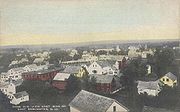
East Rochester, New Hampshire
Encyclopedia

Rochester, New Hampshire
Rochester is a city in Strafford County, New Hampshire, United States. As of the 2010 census, the city population was 29,752. The city includes the villages of East Rochester and Gonic. Rochester is home to Skyhaven Airport and the annual Rochester Fair....
, located on the banks of the Salmon Falls River
Salmon Falls River
The Salmon Falls River is a tributary of the Piscataqua River in the U.S. states of Maine and New Hampshire. It rises at Great East Lake and flows south-southeast for approximately , forming the border between Maine and New Hampshire....
, which separates Maine
Maine
Maine is a state in the New England region of the northeastern United States, bordered by the Atlantic Ocean to the east and south, New Hampshire to the west, and the Canadian provinces of Quebec to the northwest and New Brunswick to the northeast. Maine is both the northernmost and easternmost...
from New Hampshire
New Hampshire
New Hampshire is a state in the New England region of the northeastern United States of America. The state was named after the southern English county of Hampshire. It is bordered by Massachusetts to the south, Vermont to the west, Maine and the Atlantic Ocean to the east, and the Canadian...
. Home to approximately 5,000 residents, it is located 3 miles (5 km) east of Rochester proper, and is one of two villages (the other being Gonic) within city limits.
The area was a farming community which developed into a small textile
Textile
A textile or cloth is a flexible woven material consisting of a network of natural or artificial fibres often referred to as thread or yarn. Yarn is produced by spinning raw fibres of wool, flax, cotton, or other material to produce long strands...
and shoe manufacturing mill town
Mill town
A mill town, also known as factory town or mill village, is typically a settlement that developed around one or more mills or factories .- United Kingdom:...
during the Industrial Revolution
Industrial Revolution
The Industrial Revolution was a period from the 18th to the 19th century where major changes in agriculture, manufacturing, mining, transportation, and technology had a profound effect on the social, economic and cultural conditions of the times...
. Using water power from the Salmon Falls River, two mills began operation. The first was called the Cocheco Woolen Manufacturing Company, with the second smaller one built upstream and called the White Mill. Between the 1880s and 1920s, "Eastside" (as it is referred to by locals) achieved its maximum growth. It was served by the Nashua & Rochester Railroad, which later became part of the Boston & Maine Railroad. Called Rindgemere, the depot
Train station
A train station, also called a railroad station or railway station and often shortened to just station,"Station" is commonly understood to mean "train station" unless otherwise qualified. This is evident from dictionary entries e.g...
was located on Autumn Street. But during the Great Depression
Great Depression
The Great Depression was a severe worldwide economic depression in the decade preceding World War II. The timing of the Great Depression varied across nations, but in most countries it started in about 1929 and lasted until the late 1930s or early 1940s...
, the mills began to decline, and finally folded in the 1970s. With its principal employers gone, East Rochester slipped in its quality of life. More recently, however, the district has enjoyed a rebirth. Located near major routes and industrial centers, its small village ambience has attracted new residents, and several beautiful Victorian
Victorian architecture
The term Victorian architecture refers collectively to several architectural styles employed predominantly during the middle and late 19th century. The period that it indicates may slightly overlap the actual reign, 20 June 1837 – 22 January 1901, of Queen Victoria. This represents the British and...
buildings have been restored.
East Rochester consists of a main street with several small shops and a shopping center known as Shoreyville Plaza, named after the original settlement in the area. Also on Main Street are two churches and a small library. In recent years, the old fire station has been converted into a museum
Museum
A museum is an institution that cares for a collection of artifacts and other objects of scientific, artistic, cultural, or historical importance and makes them available for public viewing through exhibits that may be permanent or temporary. Most large museums are located in major cities...
, as fire services are now obtained from the main station in Rochester. A three-story block located on Main Street once housed the post office and a clothing store until the early 1980s, when the post office moved into a 2 story brick block further north on Main Street.

